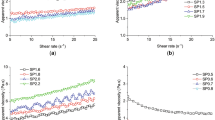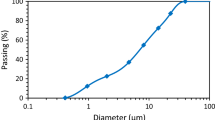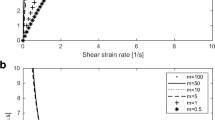Abstract
The present work reports an investigation on the rheological behaviour of fresh cement pastes. Three types of Portland cement were used. The water/cement ratio was varied in the range 0.35 ÷ 0.40. The rheological tests were performed using the coaxial-cylinder viscometer Rotovisko-Haake RV 11. The material to be tested was subjected immediately after mixing to a constant shear rate until a steady value of shear stress (equilibrium value) was attained. All the pastes tested exhibited a flow behaviour of the partially thixotropic type. A rheological model consisting of a sole constitutive equation\(\tau = \tau (\dot \gamma ,t)\) was defined according to the Cheng and Evans approach. The parameters of the constitutive equation were correlated with the cement specific surface and the water/cement ratio.
Similar content being viewed by others
Abbreviations
- a, b :
-
constants of eq. (20)
- A, C :
-
constants of the vom Berg model; see eq. (13)
- A b :
-
break-down area
- C V :
-
solid concentration
- d :
-
distance parameter
- K 1,K 2 :
-
rate constants
- p, q :
-
orders of the rate equation
- s :
-
mean square relative deviation
- S vB :
-
specific surface related to the volume
- t :
-
time
- t t :
-
characteristic time
- w/c :
-
water/cement ratio
- α 1,α 2 :
-
constants of the Shangraw model; see eq. (14)
- \(\dot \gamma \) :
-
shear rate
- η :
-
viscosity
- η ∞ :
-
viscosity at infinite shear rate
- Γ :
-
constant of the Williamson model; see eq. (17)
- λ :
-
structural parameter
- λ e :
-
equilibrium structural parameter
- τ :
-
shear stress
- τ e :
-
equilibrium shear stress
- τ f :
-
yield stress; constant of eq. (13)
- τ max :
-
initial maximum shear stress
- τ 0 :
-
yield stress
- 0:
-
structural levelλ = 0
References
Lapasin, R., Il Cemento (in the press).
Cheng, D.C-H., F. Evans, J. Appl. Phys.,16 1599 (1965).
Legrand C., Materiaux et constructions,29, 275 (1972).
Lapasin, R., V. Longo, S. Rajgelj, in: G. Astarita, G. Marrucci, L. Nicolais (eds.), Rheology (Proc. VIIIth International Congress on Rheology, Naples, 1980), Vol. 3, p. 659, Plenum Press (N.Y. 1980).
Lapasin, R., A. Papo, S. Rajgelj, Cement and Concrete Research (in the press).
Italian Ministerial Decree, June 3., 1968, in: Gazzetta Ufficiale Repubblica Italiana N° 180, June 17, 1968.
vom Berg, W., Mag. Concr. Res.,31, N° 109, 211 (1979).
Shangraw, R., W. Grim, A.M. Mattocks, Trans. Soc. Rheol.,5, 247 (1961).
Williamson, R.V., Ind. Eng. Chem.,21, 108 (1929).
Terrier, P., M. Moreau, Rev. Mater. Construct., N° 584, 129 (1964).
Author information
Authors and Affiliations
Rights and permissions
About this article
Cite this article
Lapasin, R., Papo, A. & Rajgelj, S. The phenomenological description of the thixotropic behaviour of fresh cement pastes. Rheol Acta 22, 410–416 (1983). https://doi.org/10.1007/BF01333772
Received:
Issue Date:
DOI: https://doi.org/10.1007/BF01333772




